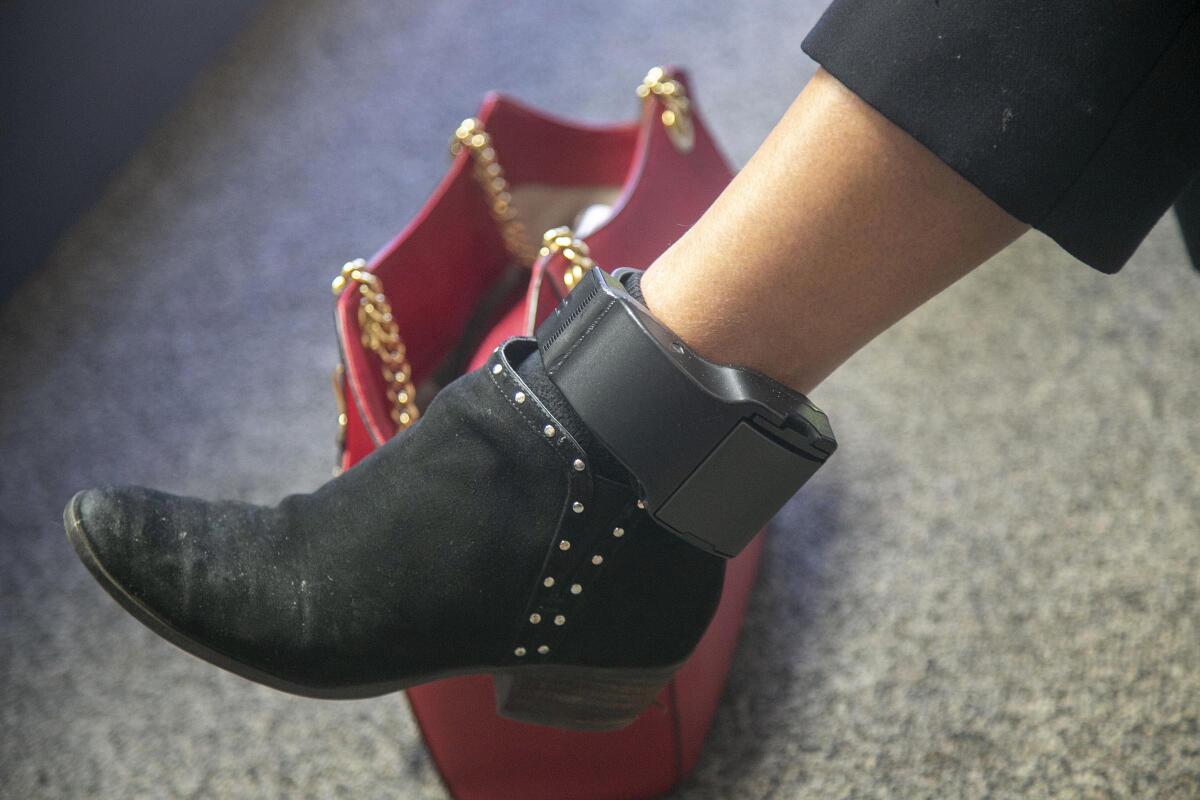The monster of incarceration quietly expands through ankle monitors

- Share via
In Los Angeles County, the number of people ordered to wear electronic ankle monitors as a condition of pretrial release went up 5,250% in the last six years, according to a recent report by the UCLA Criminal Justice Program. The figure rose from just 24 individuals in 2015 to more than 1,200 in 2021. This type of carceral surveillance is becoming the “new normal” across the U.S.
It’s widely defended as “better than jail,” but being “better than jail” does not make a criminal justice policy sound — much less humane or legal. As Michelle Alexander, the author of “The New Jim Crow,” has observed, “digital prisons are to mass incarceration what Jim Crow was to slavery.”
It’s deceptive to even compare jail and ankle monitors as though they are the only two options. There is a third option: freedom. In 2015 and before, L.A. judges were unlikely to order electronic monitoring as a condition of release before trial. Judges either set bail, released people on their own recognizance or ordered that people be detained in jail until trial.
Now, judges seem to be defaulting to electronic monitoring, perhaps for people who would — or should — otherwise be free. For people who would otherwise be in jail, monitoring may be preferable. But for people who are monitored instead of being released on their own recognizance, monitoring reflects a dangerous expansion of the carceral state.
This “E-jail” entails a web of invasive rules and surveillance technologies, such as GPS-equipped ankle monitors, that allow law enforcement to tag, track and analyze the precise locations of people who have not been convicted of any crime.
As criminal justice researchers, we are concerned. The pretrial use of carceral surveillance should never be considered “normal.” As James Kilgore and Emmett Sanders, researchers in this field, have explained, carceral surveillance inflicts needless harm and hardship on individuals who have not been found guilty.
The difference between E-jails and real jails is a matter of degree, not of kind. A recent report by researchers at George Washington University School of Law details the myriad ways that monitoring undermines autonomy, dignity, privacy, financial security and social relationships when they are needed most.
Like in jail, people on monitors lose their liberty. In L.A., as elsewhere, people on monitors are forbidden from leaving their house without pre-approval from authorities days in advance.
Like in jail, people on monitors have little privacy and must comply with dozens of strict rules governing every aspect of daily life. Failing to charge the monitoring device, changing a work or school schedule without permission or making an unauthorized trip to the grocery store can land someone back in jail for a technical violation. It is hardly surprising that in L.A. County, technical rule violations, not new criminal offenses, led to more than 90% of the terminations and reincarcerations applied to people on electronic monitors.
Ankle monitoring also further entrenches the very racial and economic inequities that bail reform sought to address. In 2021, 84% of people on pretrial electronic monitoring in L.A. County were either Black or Latinx. And in most places, though not in L.A., people on ankle monitors before trial are required to pay for the device. These fees are on top of other costs, such as electric bills (to charge the monitor), cellphone bills (to communicate with the monitoring agency) and the cost of care and transportation for family members that is required because people on monitors often cannot leave home.
And yet, monitoring is a popular option among judges. According to the UCLA report, judges in L.A. County’s Lancaster Courthouse choose electronic ankle monitoring over supervision without a monitor in more than 90% of cases between 2020 and 2021. Despite the lack of clear empirical evidence that monitoring results in fewer missed court dates or greater public safety compared with release without a monitor, the California Judicial Council gave L.A. County $17 million in 2020 to start a new supervised release program, including an extensive monitoring program.
There is, however, some reason for optimism. After years of community organizing, L.A. County’s Board of Supervisors recently passed a motion to develop an independent pretrial services agency within a new Justice, Care and Opportunities Department that takes over the role that probation plays in pretrial services. This new agency has the ability and authority to end the county’s needless reliance on electronic monitoring. We urge officials to focus on innovative solutions that rely on community-based support rather than punitive and harmful surveillance technology.
Given the recent exponential growth of electronic monitoring, and the movement toward a new pretrial services agency, we hope L.A. is poised to become a beacon of pretrial reform for the rest of the country.
Kate Weisburd is an associate professor of law at George Washington University School of Law. Alicia Virani directs the Criminal Justice Program at UCLA School of Law.
A cure for the common opinion
Get thought-provoking perspectives with our weekly newsletter.
You may occasionally receive promotional content from the Los Angeles Times.






